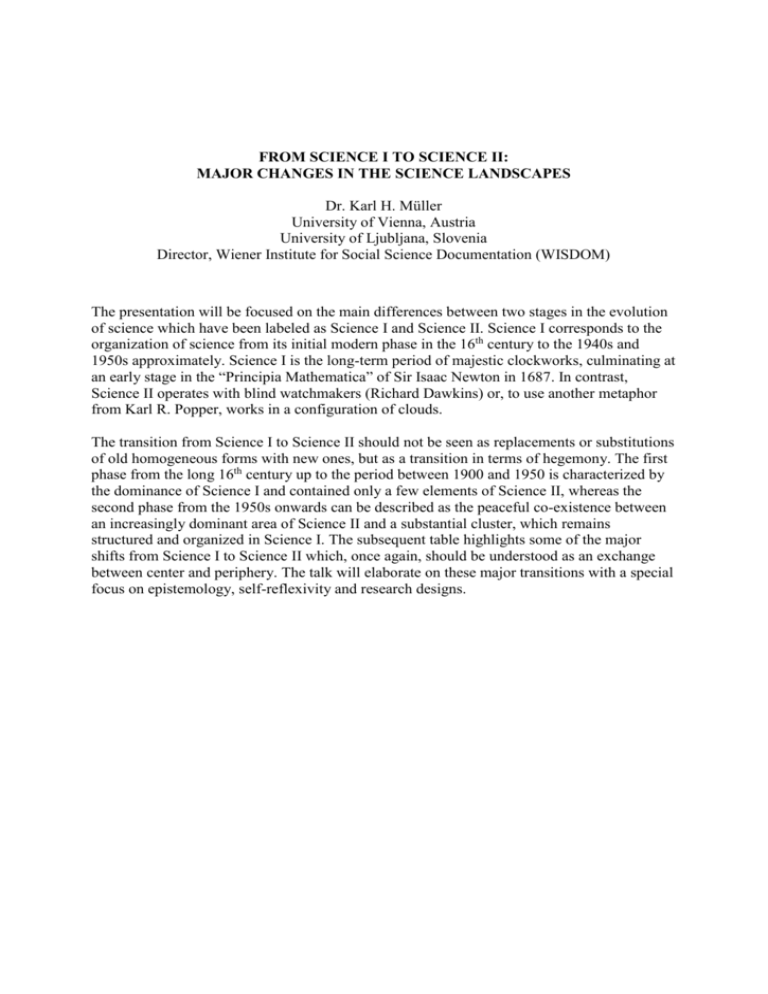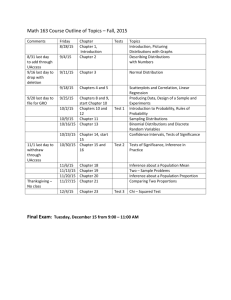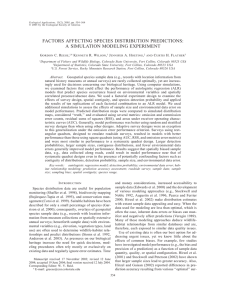Major Changes in the Science Landscapes
advertisement

FROM SCIENCE I TO SCIENCE II: MAJOR CHANGES IN THE SCIENCE LANDSCAPES Dr. Karl H. Müller University of Vienna, Austria University of Ljubljana, Slovenia Director, Wiener Institute for Social Science Documentation (WISDOM) The presentation will be focused on the main differences between two stages in the evolution of science which have been labeled as Science I and Science II. Science I corresponds to the organization of science from its initial modern phase in the 16th century to the 1940s and 1950s approximately. Science I is the long-term period of majestic clockworks, culminating at an early stage in the “Principia Mathematica” of Sir Isaac Newton in 1687. In contrast, Science II operates with blind watchmakers (Richard Dawkins) or, to use another metaphor from Karl R. Popper, works in a configuration of clouds. The transition from Science I to Science II should not be seen as replacements or substitutions of old homogeneous forms with new ones, but as a transition in terms of hegemony. The first phase from the long 16th century up to the period between 1900 and 1950 is characterized by the dominance of Science I and contained only a few elements of Science II, whereas the second phase from the 1950s onwards can be described as the peaceful co-existence between an increasingly dominant area of Science II and a substantial cluster, which remains structured and organized in Science I. The subsequent table highlights some of the major shifts from Science I to Science II which, once again, should be understood as an exchange between center and periphery. The talk will elaborate on these major transitions with a special focus on epistemology, self-reflexivity and research designs. Basic Differences between Science I and Science II Dimensions Science I Science II Leading Fields of Science Classical Physics Evolutionary Biology and the Sciences of Complexity Theoretical Goals General, Universal Laws Pattern Formation and Pattern Recognition Theory Structures Axiomatic, Reductionistic Nested, in Multiple Levels Simultaneously ResearchPrograms Closed Deductive Open, Recombinative Heuristic Rules Mechanics Critical Phenomena, Qualitative or Structural Changes Units of Method Causal Relations Generative Relations Forecasting Capacities High Low Levels of Complexity Low High Ontology Dualism Monism Epistemology (“Objectivity”) Observer-Exclusion Observer-Inclusion Re-Entries (Self-Reference) Re-Entries Excluded Re-Entries Possible Dynamics Equilibrium Linear Dynamics, Equilibrium Non-linear, far from Types of Distributions Normal Distributions, Mild Distributions Power-Law Distributions, Wild Distributions Observations, MeasureMents (Social Sciences) Flat Search Deep Search Research Designs Trivial Designs Non-Trivial Designs Potential for Interdisciplinary Research Low High Cognitive Distances between Natural and Social Sciences High Low Leading Metaphors Clocks Clouds








